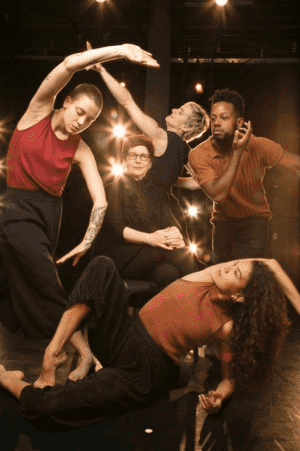A once-struggling artist has become the dance community’s benevolent landlord
Monday, February 4, 2019
A once-struggling artist has become the dance community’s benevolent landlord

Photo: Buck Ennis
Nine years ago choreographer Gina Gibney was on the verge of shutting down her struggling modern-dance company.
"I really felt like giving up," she recalled. "I got so close."
Since then, revenue at her business—simply called Gibney—has risen more than tenfold, to $6 million a year. Have audiences rediscovered their appreciation for the performing arts? Nope. But Gibney has definitely repositioned herself as New York dance's favorite landlord.
Gibney controlled a single studio a decade ago but now rents out about two dozen, covering more than 50,000 square feet in two prime Manhattan locations. Income from renting rehearsal space to Broadway shows and other ensembles accounts for a third of her revenue, enabling her to produce the sort of provocative works that have been her company's hallmark for nearly 30 years. The flow of cash also allows her to rent rehearsal studios to nonprofit organizations for a fraction of the market price—a godsend to dancers with a shoestring budget who struggle to find room to leap in the city.
"The story of dance in New York was one of retreat and losing spaces before Gina changed it," said Alejandra Duque Cifuentes, acting executive director at research and advocacy group Dance/NYC.
The economics of almost every performing arts organization are precarious at best, and in dance they're often worse, because the genre doesn't lend itself to long-running shows. The Nutcracker draws well every Christmas, and companies such as the New York City Ballet and Alvin Ailey American Dance Theater have major benefactors. But most of the city's 170 dance organizations perform for small sums in front of small crowds.
"Developing a good work takes a year, and that cost, which comes out of the artist's pocket, is way more than the public will pay in tickets," said dance producer Lisa Niedermeyer.
What's more, those small audiences are steadily shrinking. A 2016 study by Dance/NYC revealed a 20% drop in attendance over the previous six years.
The result is dance companies and studios vanishing from the scene. Dance New Amsterdam, founded in 1984, dissolved in 2014 after falling $620,000 behind in its rent and losing a $100,000 annual grant from the city. In 2016 DANY Studios in the Garment District closed after its lease expired, and the Brooklyn Studios for Dance recently launched a $15,000 fundraising drive to keep its doors open. (So far it has raised about $10,000.)
"Dance was neglected, starved for investment and on a downward spiral for a long time," Gibney said. "Something had to change."
Stepping up
Gibney, a native of Ontario in central Ohio (population: 6,225), set up her company in 1991 at 890 Broadway, a converted factory building that is the epicenter of the dance community. For years she occupied a single studio on the fifth floor and pieced together about $500,000 in revenue annually by renting to other dance companies or holding classes.
Disaster struck after the financial crisis, when donors and funding evaporated. Gibney let go of her bookkeeper, learned how to prepare spreadsheets and pleaded with famed choreographer Eliot Feld, president of the Ballet Tech Foundation, which owns her floor. "I think Eliot respected that I didn't ask for a break," Gibney said.
Feld, who performed in West Side Story on Broadway and as Baby John in the 1961 film, said his foundation didn't want to squeeze out a good tenant over a cash-flow problem. "You can't set aside the well-being of your foundation," he said, "but you can bend a bit."
As other tenants—such as the Barbara Matera costume studio and the New York University theater department—left the Flatiron District building, Gibney implored others in the dance community to move in, but none could come up with the money or make decisions fast enough. Some of the spaces weren't appealing because they'd been used for manufacturing and needed renovation. But they were big—with high ceilings and, most important, no columns—making them ideal for large ensembles. Gibney took over the spaces herself and decided to take the leap and become a big landlord.
"She was scared by the size of what she was taking on, and we were a little concerned," Feld said. "But we trusted her."
To fill the spaces, Gibney started looking beyond her roots in the nonprofit world to offer rehearsal room to well-financed Broadway productions, such as the Tony Awards and The Lion King. Word traveled fast that prime space was available, and rental income quickly flowed in. Eventually Gibney had control of all nine studios on the floor, covering 16,000 square feet. Becoming a dance studio landlord meant she had a growing source of cash, and it helped advance her nonprofit's mission to foster "the possibility of movement where it otherwise would not exist."
For Broadway productions, which typically book rehearsal space for weeks or months, Gibney charges $60 and up per hour. That affords her the flexibility to rent to nonprofits and independent dancers for $15 or less per hour. One 100-square-foot room with a wood floor and a south-facing window is available weekday mornings for as little as $3.75 an hour.
After Gibney demonstrated she had found a way to defy the punishing economics of dance, foundations took notice and began writing her big checks to support her company and its mission. A few years ago city officials approached her about taking over 26,000 square feet near City Hall at 280 Broadway, vacated after Dance New Amsterdam's bankruptcy. The city was eager for Gibney to grab the space after spending $2 million on renovations in the past decade, but she had to act before the building's landlord offered it to a commercial tenant. Her board was supportive, knowing the acquisition could shift the depressing narrative of constant evictions in the dance community.
"We had to show dancers that we could prevent the loss of another space," said the company's chairman, Dani Effron Kline, a former Showtime executive.
Gibney credits much of her business success to her partner of 28 years, Pamela van Zandt, a former Condé Nast human resources chief, whom former Vanity Fair Editor Tina Brown called "a hero to me." Gibney said van Zandt helped introduce her to the philanthropic world and even lined up contractors to renovate studio space. Van Zandt takes little credit.
"I gave her corporate advice, and a lot of it was bullshit," she said. "She's the one who said, 'We have to make money from every inch of space—no big offices, no friends-and-family hires.' That's all her."
Following her lead
Shortly after moving into 280 Broadway, Gibney secured an additional 10,000 square feet by taking over an empty bank in the building. The renovated facility gives her much more rehearsal room to rent, and it allows her to produce shows on her home turf instead of renting performance space elsewhere. Her next project: installing an elevator for dancers with disabilities. A $500,000 grant from the Howard Gilman Foundation will help.
There is also evidence that Gibney's goal of carving out affordable space for dancers is gaining traction. Last month Dance/NYC announced a $2 million grant from the Andrew W. Mellon Foundation to provide rehearsal space at 15 locations in all five boroughs at an average price of $10 an hour.
Gibney reckons she spends about 80% of her time tending to business and the rest staging cutting-edge productions that might not otherwise find an audience. Lately one of her priorities has been cultivating disabled artists, such as Perel, who began a recent show at 280 Broadway called Pain Threshold by warning the audience she would explore some dark places. She ended her hour-long show by describing how as a teenager she was raped by a co-worker. The audience was silent for a long time after the performance.
"When the artist feels supported and we provide her an opportunity to connect to the audience," Gibney said, "that's success."



